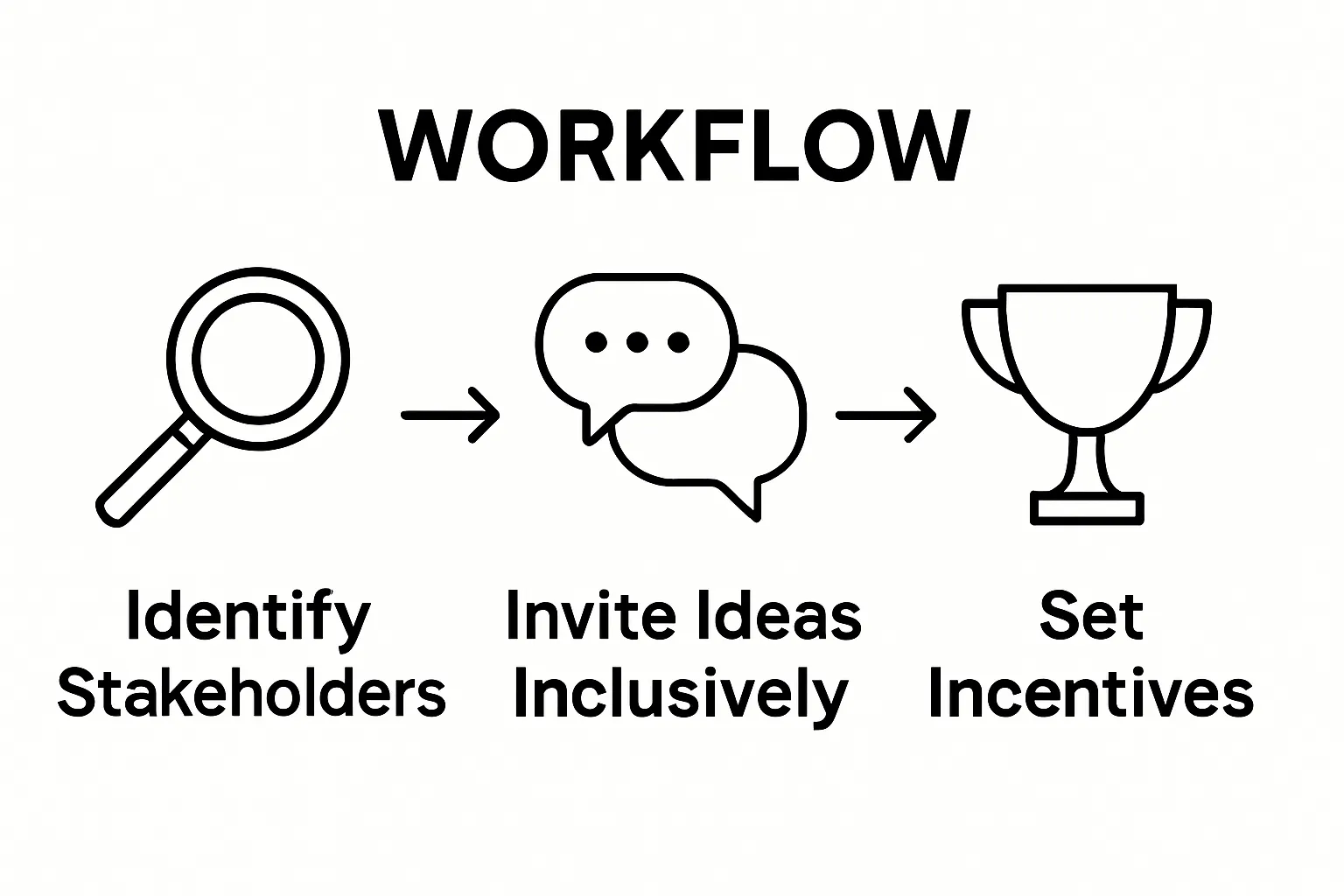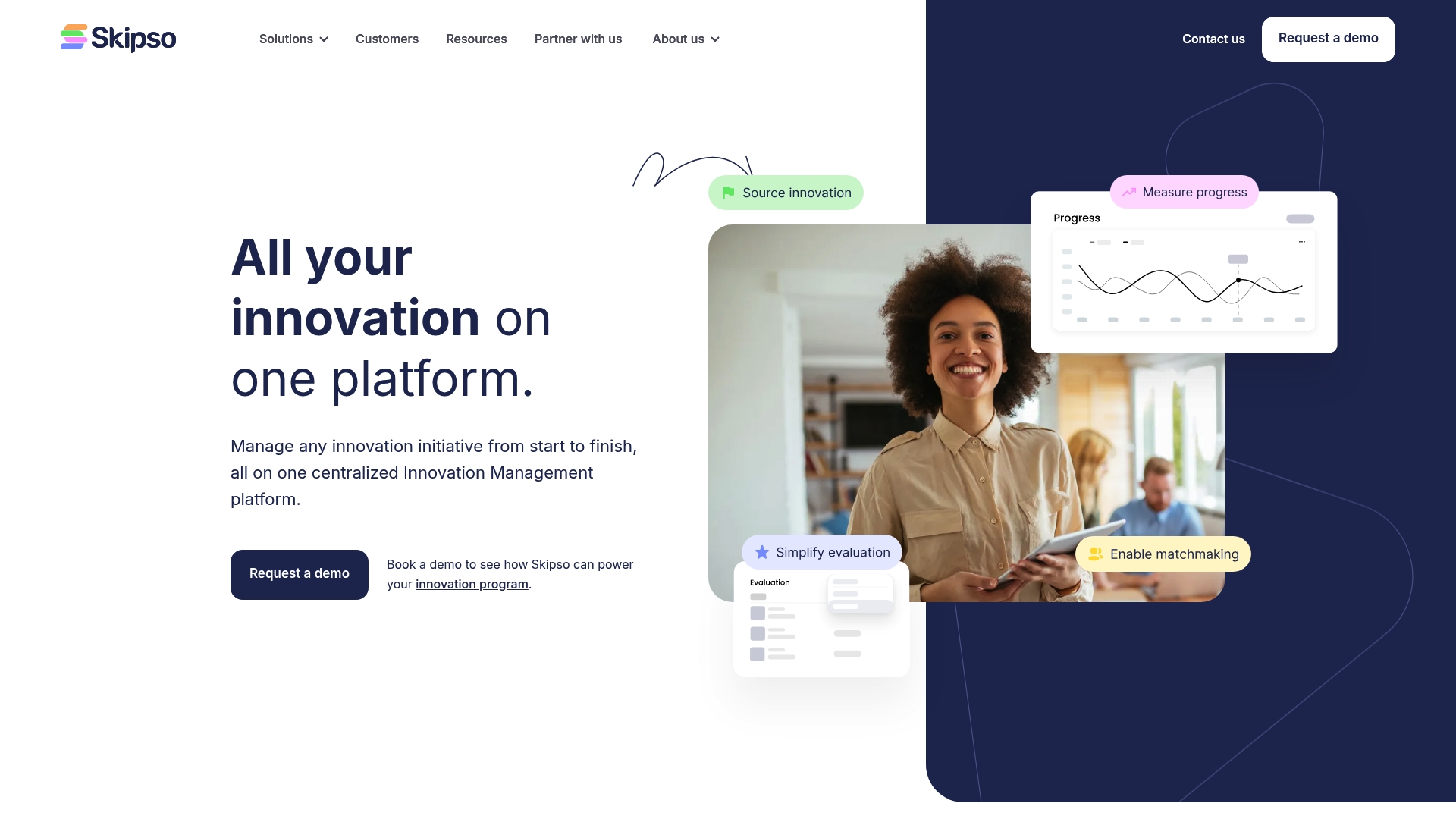


How to Encourage Participation in Innovation Initiatives
Innovation programs often struggle because the best ideas get buried or ignored. Here is something leaders miss. Organizations with diverse stakeholder input gather up to 40 percent more actionable ideas compared to those stuck in silos. Many assume driving innovation just means encouraging more brainstorming sessions or rolling out flashy tech. The real secret is knowing exactly who to bring into the process and how to keep them engaged at every step.
Table of Contents
- Step 1: Identify Key Stakeholders And Their Interests
- Step 2: Create An Inclusive Environment For Ideas
- Step 3: Develop Clear Goals And Incentives For Engagement
- Step 4: Implement Effective Communication Strategies
- Step 5: Gather Feedback And Iterate On Processes
Quick Summary
| Key Point | Explanation |
|---|---|
| 1. Identify key stakeholders for innovation | Map out individuals and groups influential to your innovation process for effective engagement and input. |
| 2. Foster an inclusive idea environment | Create a culture where all voices are valued to inspire creativity and diverse contributions. |
| 3. Set clear goals and incentives | Define specific, measurable objectives and provide meaningful rewards to enhance participation and motivation. |
| 4. Implement effective communication strategies | Establish transparent communication channels to facilitate collaboration and clarity among team members. |
| 5. Gather feedback and adapt processes | Create mechanisms for continuous feedback to iteratively improve your innovation efforts and meet stakeholder needs. |
Step 1: Identify key stakeholders and their interests
Successful innovation initiatives require a strategic approach to understanding and engaging the right people from the start. Identifying key stakeholders is more than just creating a contact list. It involves a comprehensive mapping of individuals and groups who can significantly influence or be impacted by your innovation process.
Begin by conducting a thorough stakeholder analysis that goes beyond traditional organizational boundaries. This means looking beyond immediate team members and exploring broader networks that include internal employees, external partners, potential customers, industry experts, and even indirect contributors. Learn more about managing strategic partnerships to deepen your understanding of effective collaboration.
The mapping process requires careful consideration of each stakeholder’s potential contributions, motivations, and potential barriers. For innovation managers, this means creating a nuanced profile that captures not just job titles, but deeper insights into individual and organizational interests. Consider factors like professional goals, innovation readiness, potential resource contributions, and historical engagement with similar initiatives.
To effectively categorize stakeholders, develop a comprehensive matrix that evaluates their influence, interest, and potential impact on the innovation process. This matrix should include dimensions such as decision making power, expertise level, potential resource allocation, and alignment with organizational innovation objectives. By systematically rating these dimensions, you can prioritize engagement strategies and develop targeted communication approaches for different stakeholder groups.
Successful stakeholder identification also requires ongoing dialogue and relationship building. Schedule initial discovery conversations that allow stakeholders to share their perspectives, challenges, and potential innovation opportunities. These conversations should be structured yet open ended, creating space for unexpected insights and collaborative potential.
Verify your stakeholder mapping by checking that you have comprehensive coverage across these key dimensions:
- Representation from multiple organizational levels and departments
- Diverse perspectives and expertise domains
- Balance between internal and external stakeholder insights
- Clear understanding of each stakeholder’s potential value proposition
Remember that stakeholder identification is not a one time task but a dynamic process that requires continuous refinement and adaptation throughout the innovation journey.
Step 2: Create an inclusive environment for ideas
Creating an inclusive environment for ideas is fundamental to driving successful innovation initiatives. This step transforms your organization from a traditional hierarchy into a collaborative ecosystem where creativity can flourish across all levels and backgrounds. Explore strategies for building an innovation culture to deepen your understanding of this critical process.
An inclusive idea environment starts with establishing psychological safety where team members feel comfortable sharing unconventional thoughts without fear of ridicule or professional repercussions. Leaders must actively model this behavior by demonstrating genuine curiosity and respect for diverse perspectives. This means listening attentively, asking thoughtful questions, and treating every contribution as potentially valuable.
Design structured processes that deliberately invite input from all organizational levels and backgrounds. Traditional brainstorming often privileges louder voices, so implement techniques like anonymous idea submission, digital collaboration platforms, and rotating facilitation roles. These methods ensure that introverted team members, junior staff, and individuals from underrepresented groups have equal opportunities to contribute.
Technology can be a powerful enabler of inclusive idea generation. Implement digital platforms that allow asynchronous collaboration, providing multiple channels for idea submission. Some team members might feel more comfortable writing detailed proposals, while others prefer quick voice notes or visual presentations. By offering diverse input methods, you maximize the potential for breakthrough insights.

Communicate clear expectations about the innovation process to remove ambiguity and encourage participation. Transparency about how ideas will be evaluated, potential implementation pathways, and recognition mechanisms helps build trust and motivates ongoing engagement. Regularly share success stories of ideas that originated from unexpected sources to reinforce the message that innovation can come from anywhere.
Verify your inclusive environment’s effectiveness through these key indicators:
- Diverse participation across departments, seniority levels, and backgrounds
- Increased volume and quality of submitted ideas
- Measurable employee engagement in innovation activities
- Positive feedback from team members about the idea submission process
Remember that creating an inclusive idea environment is an ongoing journey requiring continuous adaptation and genuine commitment to valuing every team member’s unique perspective.
Below is a checklist table to help you verify if your inclusive idea environment is effective, summarizing key indicators mentioned in the guide.
| Indicator | What to Look For | Evidence of Success |
|---|---|---|
| Diverse Participation | Engagement from various departments, levels, and backgrounds | Broad range of idea contributors |
| Idea Volume & Quality | Increasing number and improved substance of submitted ideas | Higher quantity and practical value of suggestions |
| Employee Engagement | Measurable involvement in innovation activities | Higher attendance in innovation sessions and platform usage |
| Positive Feedback | Favorable reviews of submission process | Satisfied team comments and survey responses |

Step 3: Develop clear goals and incentives for engagement
Developing clear goals and meaningful incentives transforms innovation initiatives from optional activities to strategic organizational priorities. This step is about creating a compelling framework that motivates participants to invest their creativity, time, and intellectual energy. Learn strategies to increase meaningful engagement to support your innovation efforts.
Start by articulating specific, measurable innovation objectives that connect directly to organizational strategy. These goals should be ambitious yet achievable, providing a clear line of sight between individual contributions and broader business outcomes. Instead of generic directives, craft goals that resonate with both organizational needs and individual professional aspirations.
Incentive structures must go beyond traditional monetary rewards. While financial recognition matters, innovative professionals are often more motivated by opportunities for professional growth, recognition, and meaningful impact. Design a multifaceted incentive approach that includes career development pathways, public acknowledgment of contributions, and tangible opportunities to implement breakthrough ideas.
Implement a transparent evaluation mechanism that provides consistent, constructive feedback. This means creating structured processes for idea review, offering detailed insights into why certain proposals advance or are redirected. Participants should understand that every submission is valued, even if not immediately implemented. The goal is to make the innovation process feel like a collaborative learning experience rather than a competitive elimination challenge.
Technology can play a crucial role in goal tracking and incentive management. Digital platforms that allow real time progress monitoring, provide interactive dashboards, and enable peer recognition can significantly enhance engagement. These tools transform innovation from an abstract concept into a dynamic, interactive experience where participants can see their contributions making a real difference.
Verify the effectiveness of your goals and incentives through these key indicators:
- Increased volume and diversity of idea submissions
- Higher cross functional participation rates
- Measurable enthusiasm and sustained engagement
- Tangible innovation outcomes linked to participant contributions
Remember that goals and incentives are not static elements. Regularly reassess and adapt your approach based on participant feedback and changing organizational needs, ensuring your innovation ecosystem remains vibrant and responsive.
Use this checklist table to evaluate the effectiveness of your goals and incentives by focusing on the suggested key success indicators from the article.
| Indicator | What to Measure | Signs of Effectiveness |
|---|---|---|
| Volume & Diversity of Submissions | Number and variety of ideas submitted | Greater submission rates and wide topic coverage |
| Cross-Functional Participation | Involvement from multiple teams | Departments collaborating on idea generation |
| Sustained Engagement | Enthusiasm and continuous participation | Ongoing involvement over time, not just one-off |
| Tangible Innovation Outcomes | Results tied to participant input | Implemented ideas traceable to contributors |
Step 4: Implement effective communication strategies
Effective communication is the lifeblood of successful innovation initiatives, transforming isolated ideas into collaborative breakthroughs. This step focuses on creating communication channels that are transparent, inclusive, and dynamic. Explore strategies for building resilient innovation partnerships to enhance your communication approach.
Begin by establishing multi channel communication platforms that accommodate different communication preferences and organizational structures. Digital tools like collaborative workspaces, dedicated innovation management platforms, and integrated messaging systems can break down traditional communication barriers. These platforms should allow for asynchronous interactions, enabling participants from different time zones, departments, and work schedules to contribute meaningfully.
Craft communication protocols that emphasize clarity, consistency, and accessibility. This means developing standardized templates for idea submissions, creating clear guidelines for feedback mechanisms, and establishing regular communication rhythms. Update participants frequently about the status of their contributions, providing transparent insights into the evaluation process, potential implementation pathways, and reasons behind decisions.
Recognize that effective communication extends beyond digital platforms. Design periodic in person and virtual forums that allow for deeper dialogue, such as innovation workshops, cross functional brainstorming sessions, and pitch events. These interactive spaces create opportunities for spontaneous connections, allowing participants to build relationships, share contextual knowledge, and develop a shared understanding of innovation objectives.
Technology can significantly enhance communication strategies. Implement AI powered analytics tools that can help track communication patterns, identify potential collaboration opportunities, and provide insights into the flow of ideas across the organization. These tools can help surface hidden connections and highlight potential innovation champions who might otherwise go unnoticed.
Verify the effectiveness of your communication strategies through these key indicators:
- Increased cross functional collaboration
- Consistent and timely participant feedback
- High engagement rates across communication platforms
- Measurable improvements in idea quality and implementation speed
Remember that communication is an ongoing process of refinement. Continuously solicit feedback from participants, remain adaptable to changing organizational needs, and view communication as a dynamic, two way dialogue that evolves with your innovation ecosystem.
Step 5: Gather feedback and iterate on processes
Gathering feedback and systematically iterating on innovation processes is the critical engine that transforms initial efforts into sustainable, high performing initiatives. This step is about creating a continuous improvement cycle that keeps your innovation ecosystem responsive and dynamic. Discover strategies for evaluating innovation processes to enhance your approach.
Design comprehensive feedback mechanisms that capture insights from multiple perspectives. These should include quantitative metrics like participation rates and idea conversion percentages, alongside qualitative input through surveys, focus groups, and one on one interviews. The goal is to create a holistic view of your innovation initiative that goes beyond surface level measurements and uncovers deeper organizational dynamics.
Implement regular review cycles that allow for rapid adaptation of your innovation processes. This means scheduling periodic assessments where stakeholders can critically examine what is working, what is not, and potential areas of improvement. These review sessions should be structured yet open ended, creating psychological safety for participants to share candid observations without fear of negative repercussions.
Leverage technology to streamline feedback collection and analysis. Advanced analytics platforms can help transform raw feedback data into actionable insights, identifying patterns and trends that might not be immediately apparent. These tools can provide real time dashboards, sentiment analysis, and predictive modeling that support more informed decision making.
Recognize that iteration is not about constant dramatic changes, but incremental, strategic adjustments. Small, thoughtful modifications often yield more sustainable improvements than radical overhauls. Focus on creating agile processes that can quickly incorporate learnings and adapt to changing organizational needs and participant expectations.
Verify the effectiveness of your feedback and iteration approach through these key indicators:
- Consistent improvement in innovation initiative performance metrics
- Increased participant satisfaction and engagement
- Faster idea evaluation and implementation cycles
- Demonstrable organizational learning and adaptability
Remember that gathering feedback and iterating is a continuous journey. Maintain curiosity, stay open to unexpected insights, and view each feedback cycle as an opportunity to refine and strengthen your innovation ecosystem.
Unlock Real Participation in Innovation: Make Your Ideas Matter
Struggling to turn broad ambitions for innovation into real participation? The article highlighted how difficult it can be to motivate true engagement, build trust across teams, and track meaningful contributions. Many organizations face stalled momentum and underused brainstorming sessions because they lack the structure and visibility needed to encourage ongoing participation. If you want breakthrough ideas, you need transparency, reliable feedback, and the right environment to include every voice.

At Skipso, we do more than offer innovation management software. Our end-to-end platform was built to support every step you read about—from identifying stakeholders and nurturing an inclusive culture to managing communications and collecting actionable feedback. With Skipso, you can:
- Run challenges that attract diverse ideas and reward engagement
- Create transparent workflows so every participant sees their impact
- Use technology to connect, evaluate, and improve your innovation process
Stop letting good ideas slip away. Experience a smarter way to manage your entire innovation lifecycle. Ready to see how Skipso can help you build a vibrant innovation ecosystem? Visit our main site now to schedule a demo or get started. The next breakthrough could come from your team—invite them to help shape what happens next.
Frequently Asked Questions
How can I identify key stakeholders in innovation initiatives?
To identify key stakeholders, conduct a thorough stakeholder analysis that includes mapping individuals and groups both within and outside your organization. Consider their potential contributions, motivations, and barriers, and create a matrix to evaluate their influence and interest in the innovation process.
What strategies can I use to create an inclusive environment for idea sharing?
Establish psychological safety by encouraging open dialogue and valuing diverse perspectives. Use anonymous idea submission techniques and technology platforms for collaboration to ensure all employees feel comfortable contributing ideas, regardless of their position or background.
How do I develop clear goals and incentives for innovation engagement?
Articulate specific, measurable innovation objectives that align with organizational strategies. Design a multifaceted incentive approach that includes career development opportunities and public acknowledgment rather than solely monetary rewards to motivate participants.
What are effective communication strategies for innovation initiatives?
Implement multi-channel communication platforms that facilitate clear and consistent dialogue. Develop templates for idea submissions, set regular communication rhythms, and create interactive forums to encourage deeper discussions and collaboration among stakeholders.
Recommended
- 5 creative ways to foster internal innovation
- Building a culture of innovation: leadership strategies and organizational change
- Building an Open Innovation Ecosystem that Produces Results
- Building an Innovation-Friendly Culture
- blog | siift | Creative Thinking Exercises for Future Entrepreneurs 2025
- Understanding Team Collaboration Guide – Optio Station: Best Project Management App for Prioritization













